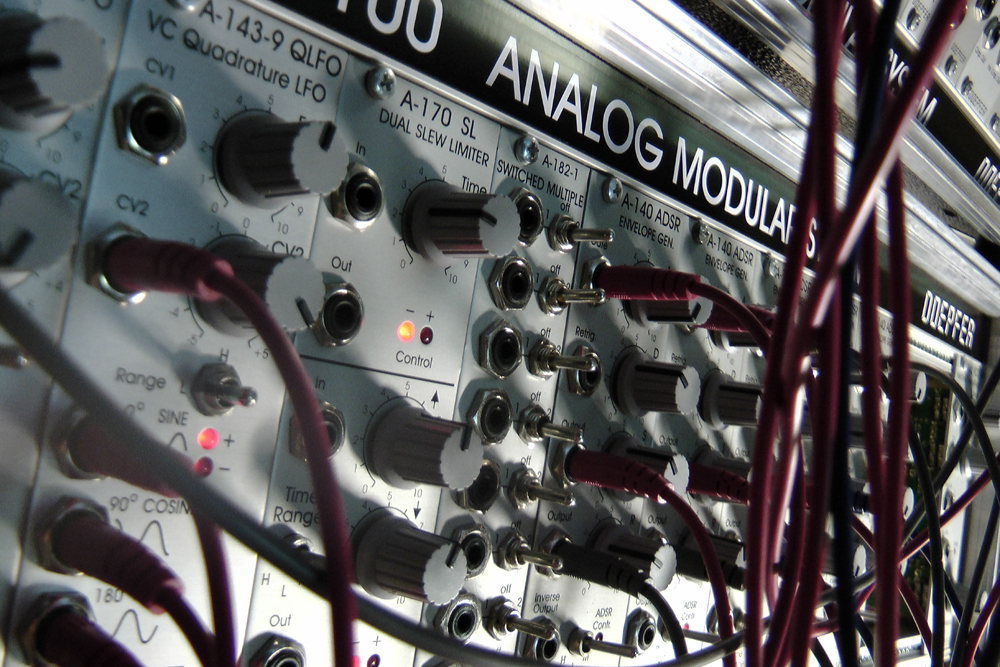This is about interdependency and randomness.
Track length is 20:27. Everything was created with an A-100, recorded without overdubs in Ableton Live and mastered in Steinberg Cubase.
Here we go:
I’m using four distinct voices here.
1. This is the most complicated voice, since it consists of four sub-voices which were switched via A-151 Sequential Switch:
1.a Three A-110 VCOs (triangle and two pulse waves) are mixed together with a suboscillator (A-115) derived from the first VCO’s pule wave. Then we go into an A-101-1 Vactrol VCF and into the A-151 Sequential Switch. The VCO frequencies are modulated by an A-155 Sequencer / A-154 Sequencer Controller / A-156 Quantizer (first VCO from a different row than the other two). Pulse widths of second and third VCO are modulated by two different triangle waves from an A-143-3 Quad LFO. The Vactrol VCF frequency is modulated by an A-143-1 Complex Envelope Generator (mix out) and by an A-140 ADSR. Filter Q is modulated by the A-143-1 as well (single outputs mixed in an A-138m Matrix Mixer).
1.b The signal created before is split up before the switch (with an A-182-1 Multiple) and sent into an A-136 Distortion/Waveshaper and then into an A-183-1 Attenuator. The result is sent into the A-151 Sequential Switch. The A-136 is modulated by two different triangle waves from an A-143-3 Quad LFO.
1.c The sine wave out of the first VCO mentioned above is sent into an A-137-2 Wave Multiplier II and then into the A-151 sequential Switch. The A-137-2 is modulated by the four outputs of an A-143-9 Quadrature LFO.
1.d Sine wave out of the first and third VCO are mixed and sent directly into the A-151.
The output of the A-151 is sent into an A-119 External In (to create something similar to compressor) and then into an A-106-5 SEM VCF (LP/HP out) and an A-131 VCA. We’re not yet finished. Then we go into an A-126 VC Frequency Shifter, whose Down and Up out are sent into two VCAs of an A-132-3. The A-131 is modulated by the same A-140 ADSR that modulates the Vactrol VCF mentioned above and by the inverted envelope out of the A-119. The two VCAs of the A-132-3 are modulated by two different „mixes“ of the A-143-1 Complex Envelope Generator, done with an A-138m Matrix Mixer.
2. Two A-111 VCOs (pulse and sawtooth waves) are sent into an A-114 Ring Modulator and then into an A-106-6 Xpander VCF. 2 pole bandpass out is put into an A-132-3 VCA and then into an A-199 Spring Reverb. The feedback loop of the reverb is sent into an A-188-2 Tapped BBD (3328 stages used, also for BBD feedback) and then into an A-108 Ladder VCF (48dB used to cut off the BBDs internal oscillator noise) before it goes back into the reverb. The first VCO is frequency modulated (linear) by the second one. VCA and VCF are modulated by the same A-140 ADSR. One A-111 VCO is modulated by the A-155 sequence used for the two VCOs of the first voice, the other A-111 is modulated by the other sequencer line – but inverted.
3. Another three A-110 VCOs are mixed together with some colored noise from an A-118 Noise Generator and then sent into a second A-108 Ladder VCF. 24dB lowpass out is then put into an A-101-1 Vactrol Phaser, an A-188-1 BBD and finally into an A-132-3 VCA. VCOs use the same sequencer line as the two VCOs from voice 1, A-108 and A-132-3 are modulated by an A-140 ADSR. The phaser is modulated by an A-147 VCLFO (tri out) and the BBD is modulated by the same sequencer as the VCOs.
4. Simple white noise from an A-118 Noise Generator is sent into an A-124 Wasp VCF, the BP out goes into an A-131 VCA and then into an A-134-1 Panner. The VCF is modulated by the random out of the A-118, the VCA by an A-140 and the Pan is modulated by the A-147 mentioned above (sawtooth out).
At the very heart of this patch is the A-143-1 Complex Envelope Generator: it is used as a modulation source for several elements as well as a trigger source for its rhythmic development. One of the comparator’s trigger outs controls the sequencer as a „main clock“, another one directly triggers the second voice (ADSR gate in). Of course, both triggers are interdependent, because they reset each other’s LFO.
The first voice is triggered by a trigger row of the A-155 (manually switched during this piece). The third voice is triggered by a „randomized“ derivative of the main clock (+/- out of an A-165 Trigger Modifier sent into an A-118 Digital Noise Generator as external clock – the resulting random clock out is used here). The fourth uses another derivative of the main clock: the above mentioned „+/-“ out is sent into an A-162 Trigger Delay and then into a second trigger modifier – again, the „+/-“ out is used (this allows for rhythmic variations by means of different length adjustments in the A-162).
Other derivatives of the main clock are used to reset the A-147 VC LFO (/32 division from an A-160 Clock Divider) and to switch to the next sub-voice input of the first voice (/64 division). A second A-155 (triggered by every step „nr. 1“ of the first one) transposes the sequence.
Have fun,
Andreas

